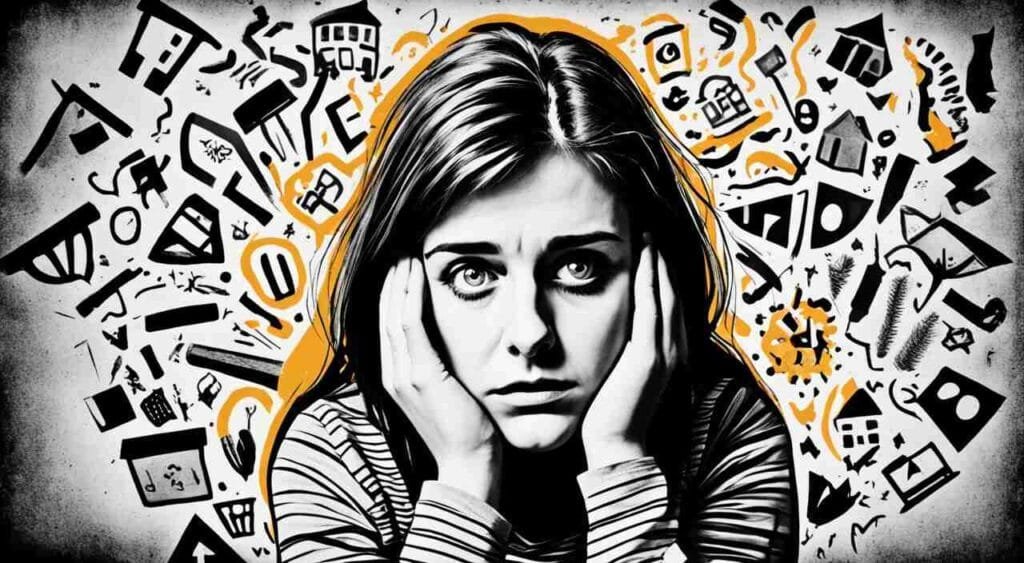The most common mood disorder in adolescence is Major Depressive Disorder. It’s marked by feelings like sadness, irritability, or hopelessness for at least 2 weeks. This makes it hard for teens to enjoy things they used to.
There are several other mood disorders teens might face. These include Persistent Depressive Disorder (Dysthymia), Bipolar Disorder, and Disruptive Mood Dysregulation Disorder. Premenstrual Dysmorphic Disorder is also common.
Key Takeaways
- The most common mood disorder in adolescence is Major Depressive Disorder.
- Mood disorders are the most prevalent mental health issues affecting teenagers.
- Other common mood disorders in adolescence include Persistent Depressive Disorder, Bipolar Disorder, Disruptive Mood Dysregulation Disorder, and Premenstrual Dysmorphic Disorder.
- Adolescents with Major Depressive Disorder may experience a depressed or irritable mood, as well as a loss of interest or pleasure in normal activities.
- Understanding the most common mood disorders in adolescence is crucial for identifying and addressing mental health concerns in teenagers.
Understanding Mood Disorders in Teens
Mood disorders cover all kinds of depression and bipolar disorder. They are common in teens, including types like major depression and bipolar disorder.
Types of Mood Disorders
Major Depression
Major Depressive Disorder is a serious form of depression. It shows in a sad or irritable mood, lack of joy in activities, and other signs for over 2 weeks. Teens with major depression may feel sad, hopeless, and have low self-esteem.
Persistent Depressive Disorder (Dysthymia)
Also called Dysthymia, this is a long-lasting form of depression. It might last for years. Teens might feel down most of the time, with symptoms not as strong as major depression.
Bipolar Disorder
Bipolar Disorder involves big mood swings and changes in energy and activity levels. Teens might feel super energized, impulsive, and happy during manic phases. These are followed by times of deep sadness.
Disruptive Mood Dysregulation Disorder
This condition is known for ongoing irritability and strong anger or frustration in teens. It can make it hard for them to control emotions and behavior.
Premenstrual Dysmorphic Disorder
This is a severe type of PMS impacting a girl’s life before her period. It shows as mood swings, irritability, and feelings of sadness.
What is the most common mood disorder in adolescence?
The most common mood disorder for teens is Major Depressive Disorder. It makes you feel sad or cranky for over 2 weeks. Teens suffering from this may not enjoy things they used to. This issue affects many high school students and young adults.
Major Depressive Disorder
Major Depressive Disorder, or clinical depression, is a big issue for teens. It can make someone feel very sad and unmotivated. This can cause problems at school and with friends. Getting help early is key to a teen’s mental health and well-being.
Causes of Mood Disorders in Teens
Understanding what causes mood disorders in teenagers is complex. Experts point to several reasons that might lead to these issues. These include imbalances in the brain’s chemicals, genetic and environmental factors, and stressful events.
Chemical Imbalances in the Brain
Studies have found a clear link between mood disorders and changes in brain chemicals. Important messengers like serotonin and dopamine help control our mood. When their balance is off, it can trigger depression or anxiety in teens.
Genetic and Environmental Factors
Teens may inherit a tendency for mood disorders if they have family members with similar issues. This link to genetics is strong. But, it’s not just about genes. Tough life events and stressful environments can also play a big part in a teen’s mental health.
Stressful Life Events
Being a teenager is tough because of all the changes they go through. Teens face stress from school, friends, or family. These pressures, like exams or moving to a new home, can make anxiety or depression worse.
Risk Factors for Mood Disorders in Adolescents
Adolescence is a key time in growing up. Knowing what can cause mood disorders then is very important. Several things can lead to mood disorders in adolescents according to facts.
Family History
Adolescents from families where teenage depression, adolescent bipolar disorder, or other youth mood disorders exist have a bigger risk. The mix of genes and family environment can lead to these issues.
Stressful Situations
Dealing with stressful life events like family problems, school stress, or tough social situations can increase the chance of mental health issues. It’s important to teach teenagers healthy ways to cope and provide a supportive place for them.
Knowing these risk factors helps everyone help teenagers. Parents, teachers, and doctors can team up to support young people’s mental health. They can also put plans in place to deal with or prevent mood disorders during this important time.
Symptoms of Mood Disorders in Teens
Teens facing mood disorders such as teenage depression, adolescent bipolar disorder, and youth mood disorders show emotional, behavioral, and physical signs. Knowing these signs early helps with treatment of adolescent mental health problems.
Emotional and Behavioral Symptoms
Teens dealing with mood issues might feel extremely sad, hopeless, or easily annoyed. They may also lose interest in things they used to love. Often, they have a hard time focusing or sleeping right. They might also eat more or less than usual, which can lead to weight changes. Other signs include being restless, finding it hard to make choices, or pulling away from friends and school.
Physical Symptoms
Besides emotional and behavioral signs, teenage anxiety and other mood disorders can affect the body. Teens might feel tired or have headaches. They could also have tense muscles and pains with no clear cause. Some teens have stomach problems like nausea or bowel changes.
Suicidal Thoughts and Behaviors
Teen psychology and young adult mental illness can sometimes lead to suicidal feelings or actions. Particularly high school students with mood disorders might think about or try to harm themselves. It’s extremely important to take any talk or signs of suicide seriously and get help right away.
| Symptom Type | Commonly Observed Symptoms |
|---|---|
| Emotional and Behavioral | Permanent sadness or irritability Loss of interest in activities Difficulty concentrating Changes in sleep patterns Significant changes in appetite or weight Restlessness and indecisiveness Social withdrawal Decreased academic performance |
| Physical | Fatigue Headaches Muscle tension; Unexplained aches and pains Digestive issues (nausea, changes in bowel habits) |
| Suicidal Thoughts and Behaviors | Suicidal ideation Suicide attempts: Self-harm |
Diagnosis and Treatment of Mood Disorders in Adolescents

Finding the right treatment for teenage depression or adolescent bipolar disorder starts with a detailed checkup by a mental health expert. They look at the adolescent mental health symptoms, health history, and any high school mental health issues.
Comprehensive Evaluation
Diagnosing mood disorders in adolescents might need interviews, questionnaires, and watching the teen in action. This approach aims to pinpoint the specific area of teenage anxiety or teen psychology that’s troubling them.
Psychotherapy
After a diagnosis, the treatment might include talking therapies like cognitive-behavioral therapy or support for dealing with relationships. These treatments help teens learn to cope, manage their feelings better, and work through the issues behind their adolescent mental health issues.
Medication
Sometimes, doctors recommend medication to help ease the symptoms of mood disorders in teens. They might suggest drugs like antidepressants or mood stabilizers. But it’s important to have regular check-ups with your healthcare provider while taking these medications.
Family Therapy
Having the family involved can make a huge difference in treating adolescent bipolar disorder and similar conditions. Family therapy aids in better communication at home, creating a more supportive family space. Every family member joins in on understanding and solving the issues related to teen psychology and high school mental health.
School Support
Working with the school is key for adolescent mental health support. This involves educators and health professionals teaming up to make school life easier for the teen. They might come up with special help, strategies, and support for teenage depression or other mood disorders in teens in the school environment.
| Diagnostic Approach | Treatment Modalities | Expected Outcomes |
|---|---|---|
| Comprehensive evaluation, including interviews, questionnaires, and potential physical exams | Psychotherapy (e.g., CBT, interpersonal therapy), medication management, family therapy, school support | Symptom reduction, improved emotional regulation, enhanced coping skills, and stronger family and school support systems |
Conclusion
In adolescence, Major Depressive Disorder is the most common mood disorder. Kids feel persistently sad, lose interest, and more for 2 weeks or longer. Conditions like depression, bipolar disorder, and disruptive mood dysregulation disorder are top mental health issues for teenagers and young adults.
The causes of these mood disorders in young ones aren’t fully clear. However, a mix of brain chemistry, genes, and tough life events seem to play a part. It’s key to spot and deal with these issues early. They can deeply affect a youth’s mental health, school work, and life satisfaction.
Help involves professional assessment, talk therapy, meds if needed, plus support from family and school. This holistic strategy makes it easier for teenagers and young adults to handle their mood disorders. It also helps them lead a full, happy life. By spreading the word and removing shame about adolescent mental health, we enable young ones to get the help they deserve. It’s all about helping them have a positive, growing experience.
FAQ
What is the most common mood disorder in adolescence?
The most common mood disorder teenagers face is Major Depressive Disorder. Teens with this disorder feel sad or easily irritated for at least 2 weeks. They might not enjoy things they used to.
What are the different types of mood disorders in teens?
Mood disorders are a big group of mental health issues that affect teenagers the most. This group includes persistent depressive disorder, bipolar disorder, disruptive mood dysregulation disorder, and premenstrual dysmorphic disorder.
What are the causes of mood disorders in teens?
We’re not entirely sure what causes mood disorders in teens. But studies suggest that things like brain chemical imbalances, genes, the environment, and tough life events can play a part.
What are the risk factors for mood disorders in adolescents?
Factual data points out that family history, tough life events, and some other factors may raise the risk of teens developing mood disorders.
What are the symptoms of mood disorders in teens?
The data shows that mood disorders in teens can have many signs, from feeling upset or angry to physical complaints, to thinking about or trying to hurt themselves.
How are mood disorders in adolescents diagnosed and treated?
To help teens with mood disorders, doctors follow a few steps. These include checking their health, sharing, and teaching them ways to feel better. Treatment might involve talking with someone, taking medicine, working with family, and getting extra help at school.





